
Virtual restaurants need these 6 digital tools

One of the first industry impacts of the COVID-19 pandemic, was that restaurants were asked to close down their dining rooms. As the entire industry shifted to focus more heavily on delivery and takeout orders, virtual restaurants began to gain new popularity.
Virtual restaurants aren’t new—they existed before the pandemic—but as the restaurant industry continues to overcome the intensely difficult challenges of 2020 and 2021, virtual restaurants have become a way for restaurateurs to increase revenue for existing restaurants, start new restaurants without high startup costs, decrease food waste, and creatively offer niche cuisines to new delivery areas in their cities.
Virtual restaurants wouldn’t be possible without certain technology, but we’ll get to that later on. First, some basics about virtual restaurants and how they work.
What Is a Virtual Restaurant?
You might have heard of a virtual restaurant before, but by a different name. They’ve been called virtual kitchens, ghost kitchens, and dark restaurants. There’s really no difference between them. They’re all names for a restaurant that exists only online.
In other words, it’s a restaurant that may have a website, may appear on third-party food delivery apps, or both. It fulfills delivery orders and maybe pickup orders for takeout, but has no dining room and offers guests no ability to dine in and eat their meal onsite.
How Does a Virtual Restaurant Work?
Usually, a virtual restaurant will be set up in one of two ways: commercial kitchens or existing kitchen/restaurant.
Because of the rising popularity of this model, many cities have commercial kitchens that rent out space for virtual restaurants to store their ingredients, prep food, and pack it for delivery. It’s then picked up from the commercial kitchen by delivery drivers, who take it to guests.
But another common type of virtual restaurant is one that’s run by an existing restaurant that already has its own kitchen space—in a brick-and-mortar restaurant or a food truck, for example. Using that existing space (and often existing leftover ingredients from their other restaurant concept), this virtual restaurant owner launches a sort of “side business” restaurant. Delivery drivers can pick up orders from the existing restaurant and deliver them to customers, who are often none the wiser that the restaurant they ordered from exists inside of another restaurant.
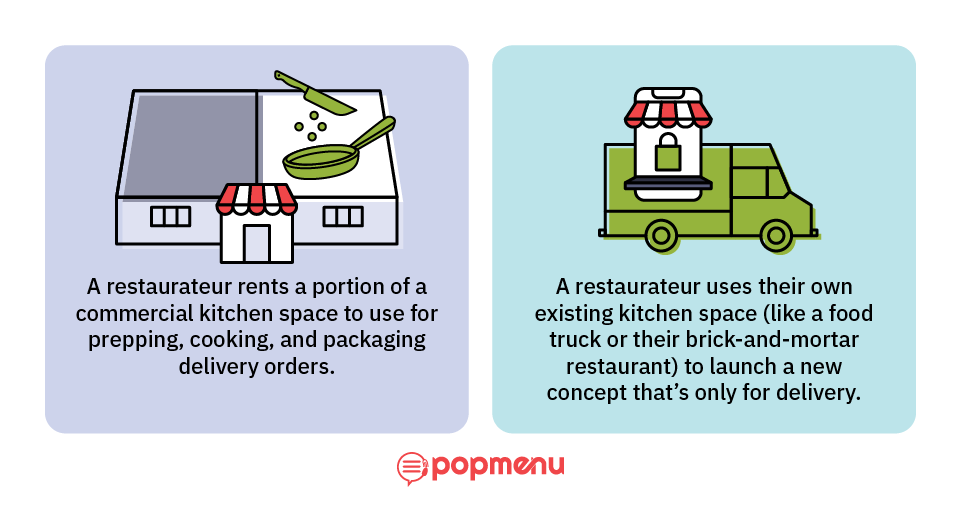
Virtual restaurants come with some big benefits. Their startup costs are generally lower than with traditional, brick-and-mortar restaurants, meaning it’s faster to get up and running and begin making a profit. One restaurateur can launch multiple virtual restaurants from the same space, allowing them to focus on niche foods and dominate different food categories. And restaurateurs who launch virtual restaurants on the side of their brick-and-mortar business can reach new markets while cross-utilizing ingredients, which boosts revenue while cutting down on costs (and food waste).
But virtual restaurants have some drawbacks, too; because they’ve exploded in popularity during the pandemic, competition among virtual restaurants has become fierce—especially in cities. The other downside is that marketing a virtual restaurant can be complex, and there’s no walk-in traffic to help boost your restaurant’s visibility.
Since they exist only online, virtual restaurants rely on digital tools even more heavily than other modern restaurants. This might be a pro or a con, largely depending on how tech-savvy a restaurant owner is.
Must-Have Tools for Digital Restaurants
While it may not be the most convenient (or cost-effective), most brick-and-mortar restaurants could continue to operate without many of the modern technologies of the digital age, if they had to. Not virtual restaurants, though. In order to function, a virtual restaurant relies fully on certain technologies.
These are the most essential tools—the ones a virtual restaurant needs to have in its toolkit in order to be successful.
Popmenu: The All-In-One Digital Toolkit for All Modern Restaurants
Popmenu is the only platform that offers all the tools virtual restaurants need to succeed.
An all-in-one digital toolkit, Popmenu combines all the technology modern restaurants need to own their online presence—a must for virtual restaurants that only exist online.
Popmenu isn’t just for virtual restaurants, but it’s an especially great tool for them. Here are 6 important technology tools virtual restaurants need—and how Popmenu provides all of them.
6 Digital Tools Virtual Restaurants Need to Succeed
Virtual restaurants absolutely must have these six tools to thrive in the competitive digital landscape where they operate.
A Responsive, Optimized Website

In the digital age, all restaurants need websites. According to Upserve, 90 percent of guests research restaurants online before visiting them—more than any other business type.
But these days, it’s not enough to just have a website. Your restaurant website needs to be responsive, meaning it adjusts automatically to be viewed properly on any size screen, creating a seamless experience for guests whether they’re viewing your website on their computer, tablet, or smartphone.
Websites also need to be search engine optimized, so guests who search for local restaurants will find yours.
Popmenu helps restaurant owners create and manage eye-catching websites, but the best part might be that every Popmenu website is automatically mobile optimized and outfitted with the best SEO tools to help your restaurant get seen by hungry guests.
An Online Menu (and Menu Management)
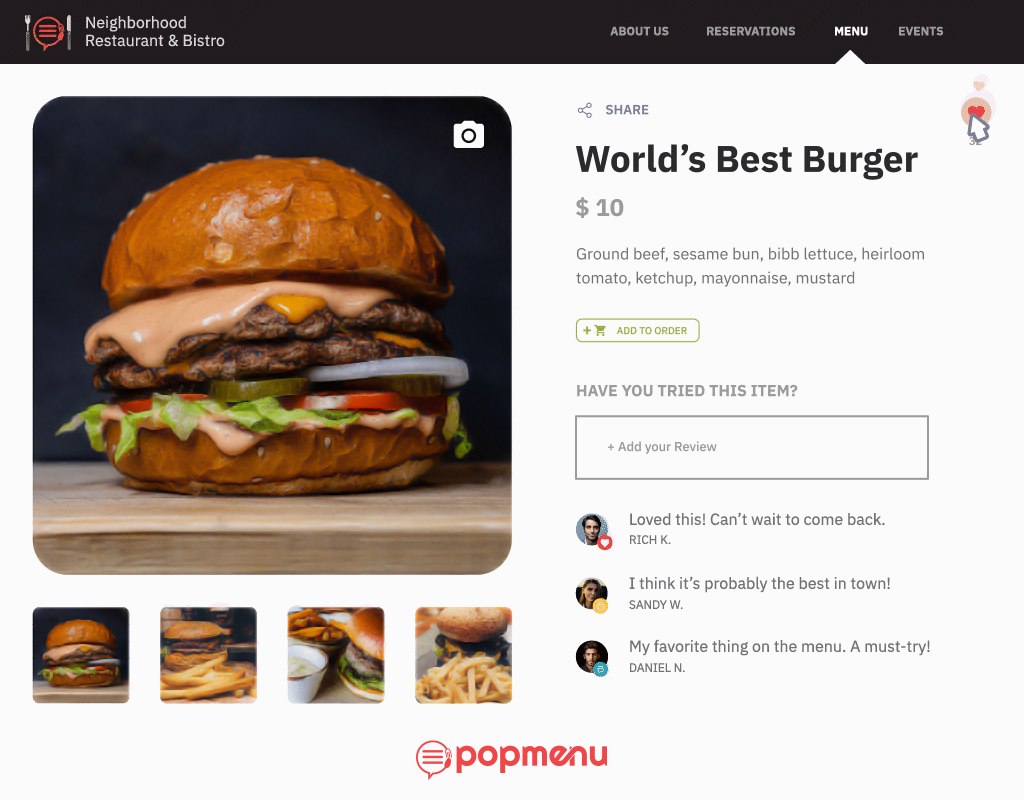
The next most important technology tool a virtual restaurant needs is a platform that allows them to post and manage an online menu.
This sounds simple, but there’s more to it than you might think. Many restaurants just create a PDF of an existing menu and add it to a page on their website. Quick and easy, right?
Unfortunately, there’s a big problem with PDF menus; 80 percent of restaurant searches take place on mobile devices. And as anyone who’s accessed and tried to read a PDF menu on a smartphone screen knows, the experience leaves much to be desired.
PDF menus require pinching and zooming and can be next to impossible to read on small screens. That’s why restaurants—especially virtual ones that rely on their online guests—need a better menu platform.
Popmenu has created one-of-a-kind menu management technology that allows restaurants to turn their menus into engaging, interactive experiences for all guests. Not only can guests view dishes on any screen size, but they can leave Pops for dishes they love, and even review individual items they’ve ordered.
Online Ordering Software
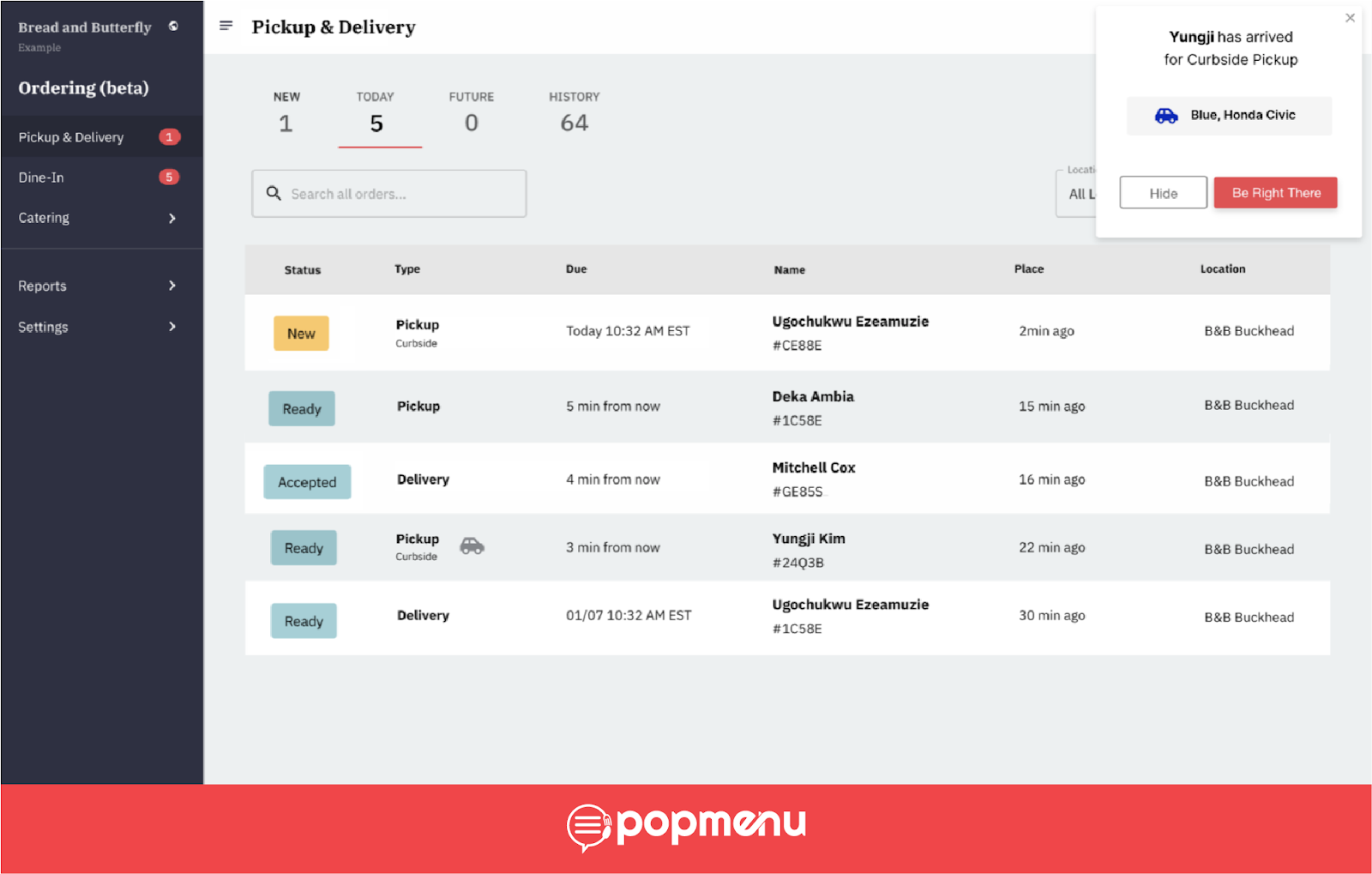
Since virtual restaurants can’t take in-person orders, they need a solid system for accepting and managing online orders.
The goal for most restaurants is to entice guests with a mouthwatering menu and get them to place an order right then and there. That means the right online ordering system will at least be linked from your restaurant’s menu—even better if guests can choose the items they’d like and order right from the menu.
Not only does Popmenu offer direct online ordering—it also allows restaurant owners to view and manage all their online orders in an easy-to-navigate dashboard.
Delivery Management
Without a dining room, virtual restaurants rely heavily on delivery orders. That means they need a way to manage deliveries and oversee a team of delivery drivers.
Many virtual restaurants turn to third-party delivery apps like UberEats, Grubhub, or Postmates for this. It’s a simpler way to manage deliveries, since it removes the overhead cost and work of employing and managing a team of delivery drivers. There’s just one downside to this: Fees. Almost all delivery platforms charge restaurants fees and commissions on orders, which eat into restaurants’ bottom line.
Popmenu has a unique partnership with DoorDash that allows restaurants to take advantage of its local networks of delivery drivers, but without all those commissions and percentages. Instead, each delivery costs one flat fee, which restaurants can charge their guests or help subsidize—it’s entirely up to them.
Digital Marketing Tools
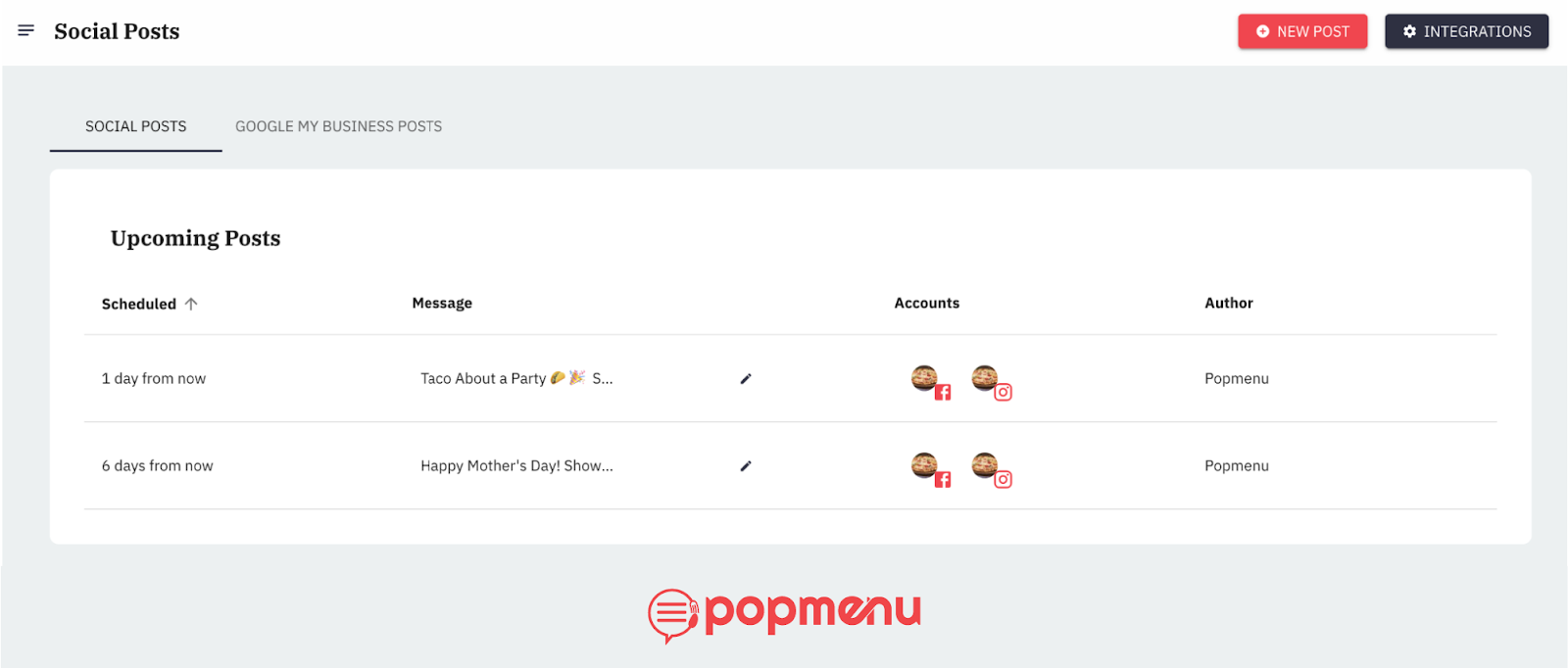
One of the most complicated things about running a virtual restaurant is marketing it to potential guests. With a traditional, brick-and-mortar restaurant, your location might be all the marketing you need—foot traffic is a tried-and-true method of capturing restaurant guests.
But for virtual restaurants, that’s not an option. They need to rely more heavily on digital marketing through their website, social media, email lists, and more. There are a ton of digital marketing tools out there, making it tough for restaurant owners to choose the right software to fit their needs—and budgets.
Popmenu makes digital marketing easy for restaurants, with Google My Business integration, easy social media posting and Facebook Ads, automated email marketing, and review management, all from within one dashboard.
Reporting and Data Analytics Software

Something that goes hand-in-hard with digital marketing is data collection, reporting, and analytics.
Restaurants that use technology tools can (and should) collect some valuable data about their guests—for example, their phone numbers and email addresses, their order history, and their ordering habits, like the time of day they tend to place orders and how much they typically spend. Those kinds of insights can help restaurants fine-tune their marketing efforts, customizing offers based on guests’ needs and behavior.
Popmenu automatically captures valuable guest data, but what’s even better is that you hardly have to do anything to make that data work for your restaurant. From automated email offers to personalized SMS messages, Popmenu makes data-based remarketing simple and straightforward, turning more first-time guests into regulars for your restaurant. Customer data can even be customized using tags and segmentation, further supporting your marketing goals.
Popmenu Has All the Tools Virtual Restaurants Need—In One Place
Technology is a must for virtual restaurants, which depend on today’s digital landscape to find and serve their guests. But instead of getting six different tools to cover these six different technology needs, they can just need one: Popmenu.
Popmenu is truly all-on-one, and it’s the only platform of its kind built just for restaurants. Want to see for yourself? Schedule a free demo today.




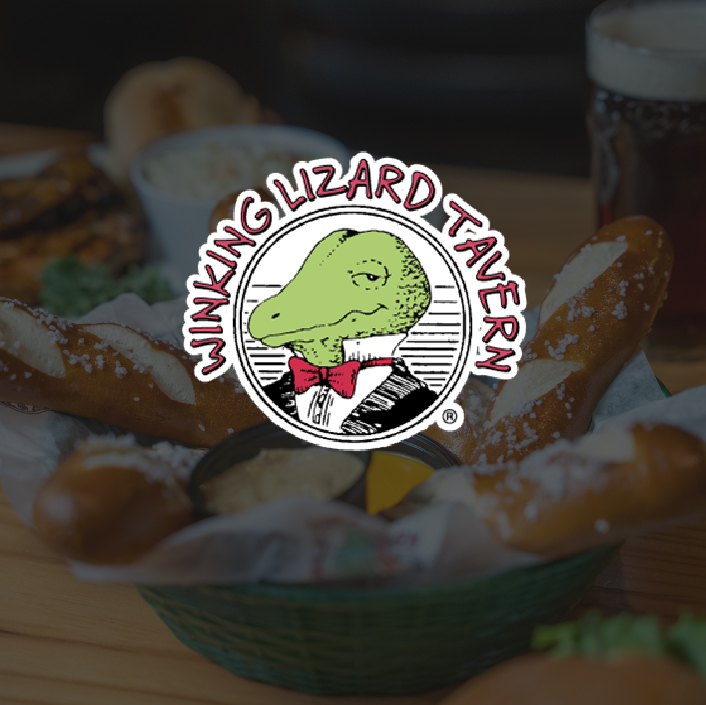
.jpeg)






